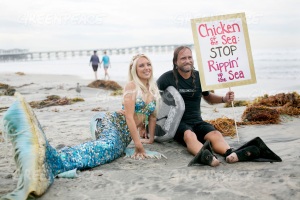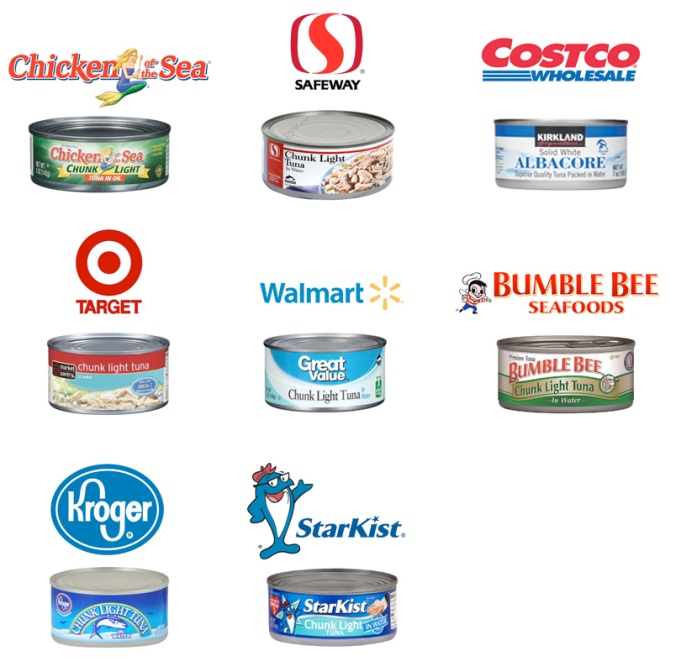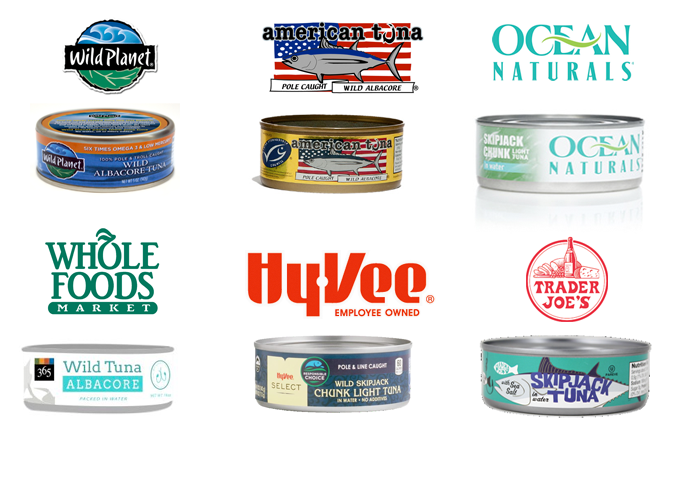#ChangeYourTuna
The LA-Tijuana trip of the Arcoiris Explorer is dedicated to ocean sustainability and the fight against tuna over fishing.
There are 2 major problems with tuna fishing and consumption.
- 1. More tuna is fished from the sea than is born in the sea.
Tuna populations are in danger of being over-fished. In a world where our favorite fish is marketed as Chicken Of The Sea, these animals are doomed for complete depletion. Tuna is not chicken! It’s a wild animal. It can only be protected by changing the way we eat tuna and changing the way we buy tuna. It’s so easy to do your part. Learn what’s good for our oceans. Avoid “canfusion” !

Mermaid protesting Chicken of the Sea Tuna along Pacific Beach in San Diego, CA on Wednesday, October 28, 2015.(Photo by Sandy Huffaker/Greenpeace)
- 2. Unethical tuna fishing methods destroy turtle, dolphin, shark and other marine species.
There are various ways to fish tuna. Some methods generate “by-catch”. It’s a fancy, industry terms for turtles, sharks, dolphins, sea-ray and other species caught in the net as collateral damage. By changing your tuna you can save these animals from unnecessary destruction. Learn how to read your tuna label and only buy tuna from a reliable, ethical and sustainable tuna company. Decode the label!
 DON’T BUY ANY OF THESE BRANDS:
DON’T BUY ANY OF THESE BRANDS:
These brands are bad for our oceans and bad for tuna and other marine life. Please do your part by not purchasing these.

THESE ARE SAFE TO BUY IN THE US:

WHAT ELSE CAN YOU DO?
Don’t feed your cat tuna!
Cats don’t need to eat tuna. Cats can get addicted to tuna. It’s not only harmful to their diet, but also contribute to overfishing and the depletion of our oceans. There are plenty of other foods that cats can enjoy. Please don’t give tuna to your kitty.
The largest cat food manufacturers, Whiskas, Iams and Dine regularly add destructively fished tuna to their catfood. Please avoid these brands for the sake of our oceans.
As a cat parent you can do your part protecting our oceans. Don’t buy cat food with tuna in it!
Support Ocean Sanctuaries
Ocean sanctuaries will protect and heal our oceans. Sanctuary means don’t take, don’t break, don’t pollute at let the ocean heal. Fish and wildlife populations can grow and come back to life again. Fishermen, politicians, businessmen and scientists all agree that these sanctuaries are great for our oceans. Let’s work together and make it happen.
SIGN THE INTERNATIONAL OCEAN SANCTUARY PETITION!
LEARN YOUR TUNA LABELS.
Tuna labels can be outright confusing. Here are some key terms you should look out for.
Bigeye
One of the most overfished tuna species. Listed as a vulnerable species by the IUCN. Avoid these products.
Bycatch
Marine life unintentionally caught and often killed when fishing, like sharks, turtles and juvenile tuna. Some fishing methods have a higher rate of bycatch than others such as conventional longlines and purse seines employing fish aggregating devices (FADs).
Circle Hook (also Longline fishing or Longlining)
This is a fishing method where a fishing line, often several miles long, is set out into the ocean with secondary lines containing baited hooks to catch tuna. Because it is so indiscriminate, sea turtles and other marine life often bytake the bait. By making the hooks more circular, it reduces the likelihood of turtles being caught on the hook. It means the brand is trying to lessen its impact on marine life — but it does not mean it is 100% sustainable.
Country of Origin
This means where the tuna was caught.
Country of Production
This means where most of the processing has taken place.
Dolphin Safe / Dolphin Friendly
Dolphin safe does not mean ocean safe. It means that one fishing method that targets tuna that swim with dolphins is not used to catch the tuna. What about the rays and turtles?!
FADs or Fish Aggregating Devices
Fish and marine life are attracted to these floating objects. When used with purse seine nets they can result in the catch and death of various species.
FAD Free
This tuna was caught by purse seine nets without the use of fish aggregating devices (FADs), which attract and result in the catch of lots of animals other than tuna. A better choice.
Free School Caught
This is another way of saying FAD Free. It means that the tuna were caught by purse seine nets not using fish aggregating devices (FADs) or setting on marine mammals. Other marine life are less impacted when fishing free school, so it is a better option.
Friend of the Sea
This phrase actually indicates a certification scheme of sustainable seafood products from fisheries and aquaculture. Not the most rigorous of certifications. Make sure to look at how the tuna was caught and if the species is a better option.
Handline
A single fishing line is held in a fishers hand to catch tuna one by one. Impacts on other species are minimal. A more sustainable choice.
Illegal, unreported, unregulated (IUU)
Also known as pirate fishing, they steal fish, exacerbating the overfishing crisis.
Light tuna
A term used to refer to skipjack, yellowfin, and sometimes bigeye tuna. Most often it will be skipjack, but check the ingredients list to be sure.
Long lines (also Longliners or Longlining)
Fishing lines sometimes dozens of miles long, baited with thousands of hooks. Very indiscriminate fishing gear and highly destructive.
Marine reserves (or ocean sanctuaries)
Similar to national parks on land, they are areas free from fishing and other industrial activities. Safe havens like this are essential to replenish marine ecosystems.
MSC
The Marine Stewardship Council (MSC) is a certification scheme for wild fisheries. MSC certified products are supposed to meet certain sustainability criteria. Certified products carry a blue and white logo with a fish and a check mark. In many cases, it means a better option for tuna, but best to also look for what species is inside and how it was caught.
No Longlines
This tuna was caught without using longlines, which stretch for miles with thousands of hooks that can cause the drowning of species incidentally caught like seabirds, sharks and turtles. “No longlines” on the label is a sign of a an ocean safe option!
Ocean Wise
The Vancouver Aquarium’s Ocean Wise logo can be found on some products that the organization deems sustainable. Ocean Wise recommendations are determined using the Monterey Bay Aquarium’s Seafood Watch Program assessment methodology. Likely a better option, but the logo is not always well policed.
Pole and Line Caught (could read just “Pole Caught”)
A fishing methods that catches tuna one-by-one with the use of a pole, usually several fishers line the perimeter of a boat and catch the tuna at the same time using baitfish. Impacts on other species are minimal. A best choice.
Pole and Troll Caught
This means the tuna was either caught using pole and line or troll. The tuna was not separated to help determine the exact fishing method it came from, so the specific method is not labeled. Both are better options.
Purse seines
Giant nets that encircle schools of fish and then are drawn tight like a drawstring purse. Very destructive when used with fish aggregating devices (FADs) and how most tuna is caught. Look for FAD-free instead.
Responsibly Caught
You need more information to ensure this is true. Some brands have this as a label they use, but dig a little deeper to find out what this means before taking their word for it.
Skipjack
The most abundant species of tuna. Often noted as light tuna on the can.
Sustainably Caught
Unless this is accompanied by information about the species and how it was caught, don’t take their word for it.
Troll Caught (also Troll)
Turtle Safe
This means that a fishing method was employed that prevents the accidental catch of turtles. It’s usually found on products caught using pole or troll methods.
Wild Caught
This just means that the tuna was caught in the ocean and not farmed (which is very rare for canned tuna species). It sounds nice, but means nothing when it comes to its sustainability.
White tuna
A term used to describe albacore tuna.
Yellowfin
A species often found in cans in the US. Sometimes referred to as light meat. Many stocks have been overfished and have suffered declines. Best to avoid.